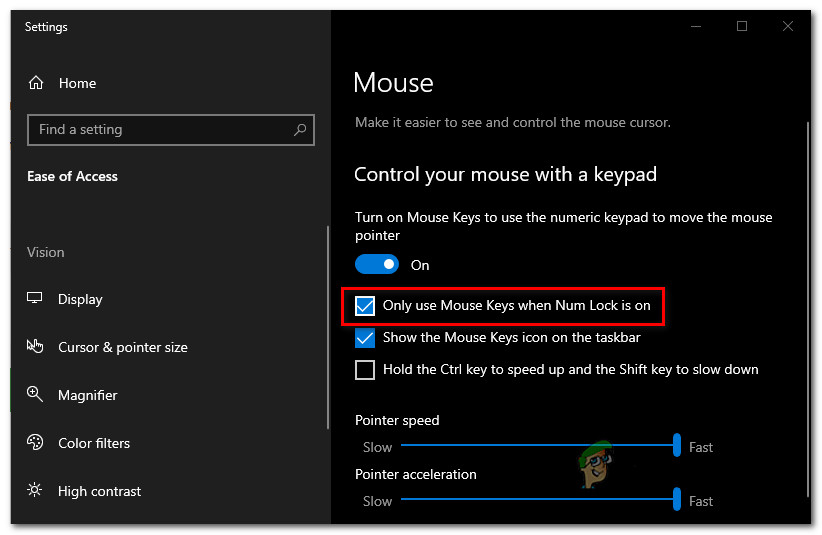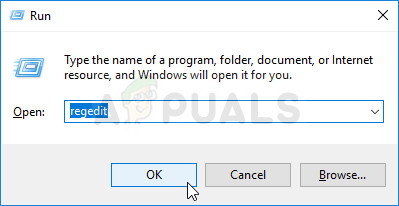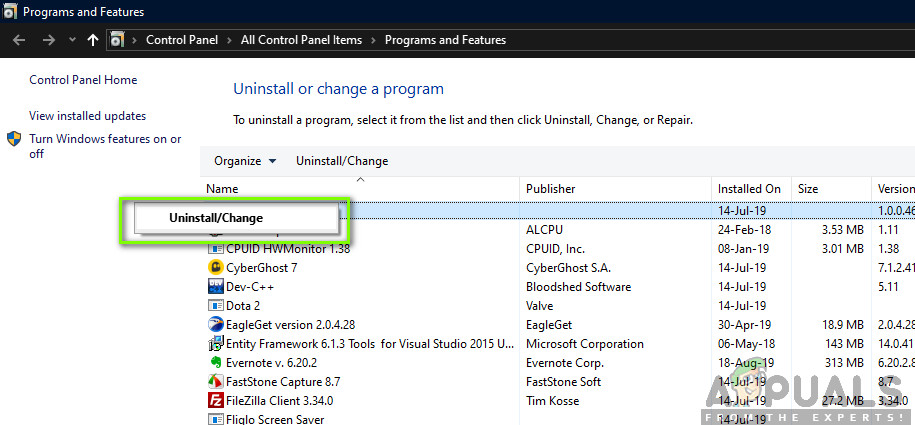How to Fix ALT Codes not Working on Windows?
Several Windows 10 users are reporting that they are suddenly unable to use ALT codes. While some users have an issue with several different Alt Codes, some users can’t use them at all. In most cases, the output is exactly the same character regardless of the alt code that is being entered. For most issues, the apparition of this issue seems to be abrupt and started occurring with no apparent trigger. As it turns out, the issue is exclusive to Windows 10 as we found no reports of the issue occurring on older Windows versions.

What is causing ALT Codes to stop working on Windows 10?
We investigated this particular by looking at various user reports and by analyzing the most popular fixes that affected users have deployed in order to resolve the issue. As it turns out, this particular problem can surface from a number of different causes. Here’s a shortlist of causes that could lead to the ALT codes issue:
- Mouse keys don’t work when NumLock is On – One of the most common causes for this error are instances where the use of mouse keys when Numlock is on is not permitted. If this scenario is applicable, you will be able to resolve the issue by changing the default behavior so that the mouse keys are on when Numlock key is on.
- The entry of Unicode is not enabled via Registry Editor – It’s possible that your Registry contains a specific key that is preventing Unicode characters from being added via Alt keys. In this case, you will be able to resolve the issue by adding an additional string value to the Input Method key.
- 3rd party interference – As it turns out, there is certain Voice over IP applications that are known to cause this behavior. Mumble and Discord are two apps that are commonly reported to cause this issue. Several users that encountered this problem while one of these applications was installed have reported that the issue was only resolved after they uninstalled them for good.
- Special Char registry is corrupted – In rare situations, this problem can also be caused by inconsistency with the registry that keeps track of all ALT characters. If this scenario is applicable, you should be able to circumvent the problem by using the Character Map to add special characters. Additionally, you can consider 3rd party alternatives like Sharpkeys or Keytweak
If you’re currently for solutions capable of resolving this error message, this article will point you towards several different troubleshooting guides that might help you fix the problem. Down below, you’ll discover several different potential fixes that other users in a similar situation have used successfully to resolve the issue.
For the best results, we advise you to follow the methods below in the same order that they are presented in (we ordered them by efficiency and severity). Eventually, you will encounter a potential fix that will allow you to resolve the issue regardless of the culprit that’s causing the issue.
Let’s begin!
Method 1: Enabling Mouse Keys when Numlock is ON
If you’re only encountering this issue when you’re trying to use the ALT codes using the Numpad, it’s almost always because you need to enable a Mouse option from the Ease of Access menu.
Several Windows users that we’re struggling to resolve the same problem have reported that the issue was resolved completely after they accessed the Mouse tab of the Ease of Access menu and enabled the ‘Use Mouse Keys when Numlock is On’ option.
However, if you’re also encountering the same issues even when you use the regular numerical keys, this option will not resolve the issue.
If you think this method might be applicable to you, follow the instructions below to access your Ease of Access settings and make the necessary modifications:
- Press Window key + R to open up a Run dialog box. Next, type ‘ms-settings:easeofaccess-mouse‘ and press Enter to open up the Mouse tab of the Ease of Access menu.

Ease of Access Mouse menu - Once you arrive at the correct menu, move over to the right-hand section of the screen and enable the toggle associated with Turn on Mouse Keys to use the numeric keypad to move the mouse pointer‘.
- After you do this, you’ll see a couple of additional options popping up. Ignore the rest and only ensure that the toggle related to Only use Mouse Keys when Num Lock is on is enabled.

Enabling the toggle associated with ‘Only use Mouse Keys when Num Lock is ON’ - After the option above is enabled, restart your computer and see if the issue is resolved at the next system startup by trying to use ALT codes once again.
If the same issue is still occurring, move down to the next method below.
Method 2: Enabling Entry of all Unicode characters via Regedit
If method one didn’t allow you to resolve the issue, another way to go around resolving this problem is to ensure that you enable the entry of all Unicode characters by code. This can be accomplished by adding a string value to the Input Method key using Registry Editor.
After doing this modification, you will be able to enter any ALT character by holding down the Alt key, pressing the numeric keypad and entering the hex code. Several affected users have confirmed that this method allowed them to fix the functionality of the ALT keys on Windows 10.
Here’s a quick guide through enabling the entry of all Unicode characters using the Registry Editor:
- Press Windows key + R to open up a Run dialog box. Then, type “regedit” inside the text box and press Enter to open up Registry Editor. When you’re prompted by the UAC (User Account Control), click Yes to grant admin privileges.

Running the Registry Editor - Once you’re inside the Registry Editor, use the left-hand pane to navigate to the following location:
HKEY_CURRENT_USER\Control Panel\Input Method
Note: Additionally, you can paste the location directly into the navigation bar and press Enter to get there instantly.
- Next, right-click on Input Method (from the left-hand pane) and choose New > String value.

Creating a new string value inside the input Method key - Name the newly created string value to EnableHexNumpad. Then, double-click on it from the right-hand side pane and set it’s Value data to 1 and click Ok.

Assigning the correct value to the EnableHexNumpad string - Close Registry Editor, restart your computer and wait for the next startup to complete in order for the changes to take effect.
- In order to enter a character, hold down the Alt key and press the + button (on the numeric keypad). Next, enter the hex code and release the Alt key to add the character.
If you’re still unable to use ALT characters, move down to the next method below.
Method 3: Uninstall interfering application (if applicable)
As it turns out, there are also several applications with the potential of suppressing the use of the Alt keys. The reason for this is that they are kept open for dedicated use. In most cases, the ALT key is used to enable or disable the push-to-talk feature, which effectively breaks the ability to use ALT characters.
Mumble is most commonly reported as the voice-over IP app causing this issue, but there are certainly others that will also do this.
Several Windows 10 users that found themselves in an identical scenario have managed to get the issue resolved simply by uninstalling the app that was causing the interference.
Here’s a step-by-step guide on uninstalling the application that is causing the problem:
- Press Windows key + R to open up a Run dialog box. Then, type “appwiz.cpl” inside the text box and press Enter to open up the Programs and Features menu.

Type appwiz.cpl and Press Enter to Open Installed Programs List - Inside the Programs and Features menu, scroll down through the list of installed applications and locate the app that is causing the interference. Once you see it, right-click on it and choose Uninstall from the newly appeared context menu.

Uninstalling the interfering Application - Follow the on-screen prompts to complete the uninstallation, then restart your computer and see if the issue is resolved at the next system startup.
If the issue is still occurring or the method above wasn’t applicable, move down to the next method below.
Method 4: Adding ALT characters using the Character Map
If none of the methods above worked for you, you should be able to use ALT characters using the Character Map, but this process is a little time-consuming. Several Windows users that have been unable to use the ALT characters conventionally have reported that they managed to circumvent the issue entirely by using the Character Map.
Here’s a quick guide on adding ALT characters using the Character Map:
- Press Windows key + R to open up a Run dialog box. Next, type ‘charmap’ and press Enter to open up the Character map.
- Once you’re inside the Character Map, simply scroll through the available fonts and click on a special character that you want to insert.
- Then, click the Select button to copy it to your clipboard.
Note: Notice that the Keystroke is also displayed in the bottom-right corner of the screen. Use that to verify whether you were typing the right number combination. - Use Right-click > Paste or Ctrl + V to paste the special character you copied at step 3.

If this solution is not to your liking, move down to the next method below to review some 3rd party alternatives.
Method 5: Using 3rd party alternatives
If none of the methods above have allowed you to restore the normal functionality of the Alt keys, you might want to consider a 3rd party alternative. Several affected users have reported that they were finally able to use the ALT keys effectively by using 3rd party programs like Sharpkeys or Keytweak.
These 3rd party solutions will allow you to edit and remap keys in a manner that is way easier than doing it manually and getting lost in the official documentation.
A popular fix using these tools is to map the right control key to the left ALT key, so you eliminate any interference caused by other functionality being mapped to the same key.





